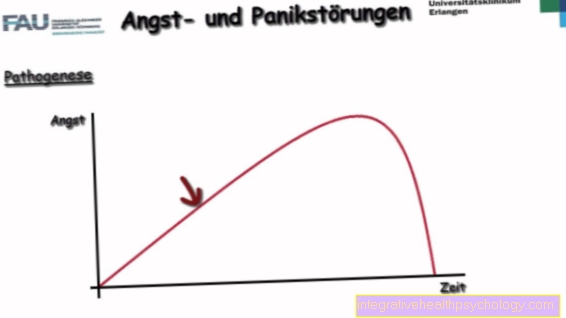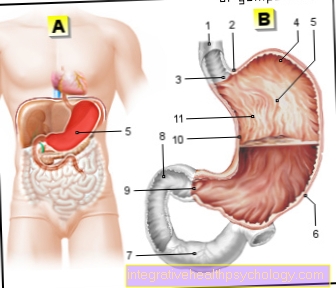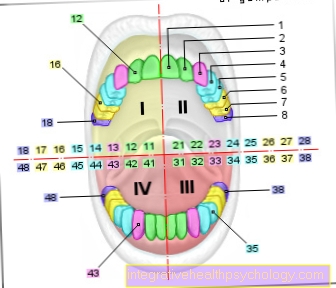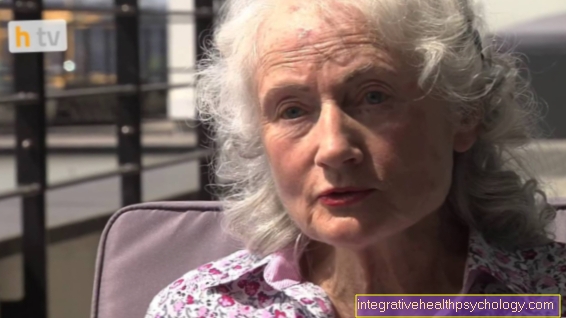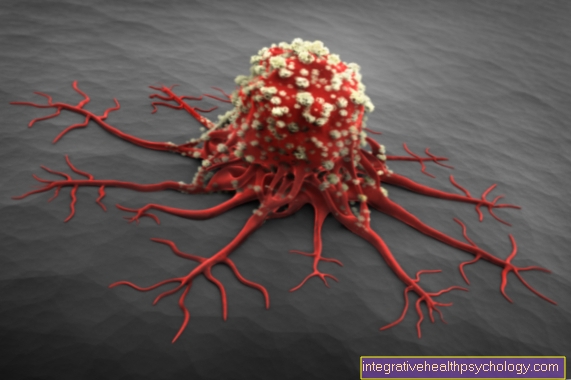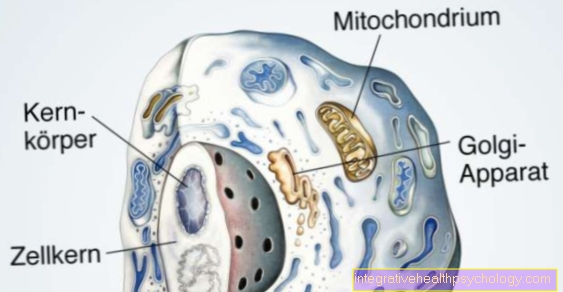Korsakoff syndrome
Definition - What is Korsakoff Syndrome?
The Korsakow syndrome is a form of the so-called anamnestic syndrome, which is largely characterized by severe memory disorders. The main focus of the symptoms is that new content can no longer be transferred to memory (anterograde amnesia).
It is also typical that those affected fill the memory gaps that have arisen with invented content, which is known as “confabulating”. Accordingly, those affected rarely have insight into the disease. In addition to the pronounced memory disorder, an orientation disorder, a reduction in drive and a flattening of the emotional vibration often occur. The frequency of the disease in Germany is given as 0.3-0.8%.
Read more on the subject at: amnesia

Causes of Korsakoff Syndrome
The development of Korsakoff's syndrome is in all cases due to damage to certain areas of the brain. The causes of this damage can, however, be very different.
- The most common cause of this damage is a thiamine deficiency (vitamin B1), which manifests itself in structural brain damage over a longer period of time. The vitamin deficiency is usually the result of malnutrition as a result of excessive alcohol consumption in the sense of addiction. This deficiency usually leads to a special inflammation of the brain, the so-called Wernicke encephalopathywhich then leads to the brain damage. The frontal areas of the brain and the structures of the so-called limbic system are primarily affected by this damage. The latter is assigned a decisive role in the regulation and generation of emotions, as well as the transfer of content into the memory.
- In addition to the vitamin deficiency in the context of alcohol addiction, other causes can lead to damage in these areas of the brain. These include, for example, a stroke of the anterior cerebral artery or extensive cerebral hemorrhage.
- Severe traumatic brain injuries can also lead to this type of damage.
Nevertheless, the vitamin deficiency and the resulting Wernicke encephalopathy are by far the most common cause of Korsakoff syndrome. Because of this close association, one often speaks of Wernicke-Korsakoff syndrome.
Please also read:
- Consequences of alcohol
- Memory Problems Caused by Drugs - Causes & Therapy
- Transient global amnesia
diagnosis
The greatest importance in the diagnosis of Korsakoff's syndrome is assigned to the clinical picture of the disease. For example, an experienced doctor can suspect Korsakoff's syndrome after a detailed survey of the medical history, guided by the typical memory disorder.
This occurs especially when the patient or their loved ones report excessive alcohol consumption.However, a previous stroke or trauma can also provide groundbreaking clues. In addition to the clinical interview, an imaging method such as MRI or CT is always used in patients suspected of having this disease in order to detect the underlying damage to the brain substance at the expected location.
In addition, laboratory tests are carried out, such as a vitamin determination, as well as an EEG and an examination of the nerve water (liquor puncture). The latter investigation serves primarily to differentiate it from other memory disorders, such as Alzheimer's disease.
Also read: What are the consequences of a cerebral hemorrhage?
What tests for Korsakoff syndrome are there?
Since the clinical presentation of patients with Korsakoff's syndrome is largely characterized by a strong memory impairment, several different tests are used to show possible functional impairments of memory.
These tests are mostly specific for certain functional areas of our memory. The tests must be able to distinguish whether the long or short-term memory is affected and whether the memory disorder only disrupts the storage of new content or makes past memory content no longer accessible.
- Short-term memory is checked, for example, by simply memorizing words. At the beginning of a conversation, those affected are given three terms that they have to repeat after 15 minutes. Patients with Korsakoff's syndrome would be conspicuous in this test and would probably invent three terms of their own.
The various tests are summarized in so-called test batteries. The best-known representative of these test groups is the minimal mind test, which is very often used when dementia or anamnestic syndromes are suspected.
More about this topic can be found: Long-term memory
Mini Mental Status Test (MMST)
The MMST was developed in order to be able to use a simple screening method to assess cognitive deficits in everyday clinical practice. Since its introduction in 1975, the MMST has distinguished itself as a very reliable test method. It is the most widely used diagnostic tool in Alzheimer's and dementia diagnostics. The MMST is ideal for measuring the degree of severity and for monitoring the progress of existing therapy. Cognitive deficits are checked over a large area using a 30-point system and the following skills are examined: orientation, memory, concentration and arithmetic, language, understanding listening and following instructions as well as tracing.
Expiry of MMST
The mini mental status test takes about 15 minutes and should be performed by a medical assistant or specialist. The test person is first asked about his or her temporal orientation. The date and day of the week as well as the year, month, day and season should be mentioned. If it turns out that the test person is time-oriented and knows the correct date immediately, a more precise inquiry can be dispensed with. The test person receives one point for each individual fact.
Checking the spatial orientation is similar. In doing so, reference is made to the current location of the test person by asking them about the country and state, the city, the facility and the floor on which they are located. Then the test person is given three simple words (e.g. car, flower, candle). He should repeat this directly and keep it in his short-term memory for a moment. This is followed by an easy math problem in which the test person has to subtract 7 from 100. From the resulting result 7 must be subtracted again and so on. The invoice is valued up to 65. If the test person does not name the correct result, this will be given to him so that he can continue the task. If the test person is unable to successfully complete the calculation, they can alternatively be asked to spell the word “radio” backwards. In both cases the concentration of the test person is checked. After the intermediate task, the memory test is completed. To do this, the test person should repeat the terms just memorized (e.g. car, flower, candle). For each term that is remembered, the test person receives one point.
Subsequently, the linguistic skills are checked by naming a wristwatch and a pencil and saying any sentence afterwards. Here are some verbal instructions that are formulated by the tester. The patient should, for example, pick up a sheet of paper and fold it up. Understanding reading is checked by a written request ("Close your eyes!"). If the test person follows the instructions, he receives points again. At the end of the test, the respondent's fine motor skills and constructive thinking are checked by having him write a complete sentence and trace a shape.
What can you see in the MRI of the brain?
The MRI of patients with Korsakoff syndrome can usually detect damage to the brain substance in certain areas. In addition to abnormalities in the anterior brain area, degenerations in the so-called limbic system can often be detected.
The term limbic system describes a network of different structures in our brain, whose functions lie primarily in the generation and control of emotions and certain memory functions. The so-called mammalian bodies belong to this system. In almost all Korsakov patients, these show significant degeneration, which can explain the severe memory disorders in these patients.
If the development of the disease can be traced back to rarer causes, such as a stroke or trauma, these can also be shown in the MRI.
You can find detailed information on the subject of "MRI" under: MRI of the brain
How do you differentiate Korsakoff syndrome from dementia?
The Korsakoff syndrome is basically assigned to the so-called anamnestic syndromes and not to the type of dementia. While the significantly reduced memory and disorientation can also be signs of dementia, the two disease groups differ significantly in other aspects.
- Anamnestic syndromes such as Korsakoff's syndrome are characterized by a decline in memory. However, there are seldom severe limitations in some cognitive performance, as is the case with certain forms of dementia.
- Differentiating the anamnestic syndromes from dementia is particularly important when planning further therapy, since in Korsakoff's syndrome patients, appropriate training can improve many cognitive functions to a certain extent.
Also read: How do I recognize dementia?
These symptoms indicate Korsakoff's syndrome
The spectrum of symptoms of Korsakoff's syndrome includes a number of different neurological and psychological symptoms, the constellation of which is relatively specific for this clinical picture.
- The leading symptom of the disease is a pronounced memory impairment (amnesia). The ability to remember new content is particularly impaired, which is known as anterograde amnesia. Those affected often no longer remember what they just said or why they just got up. In conversation there is often an unconscious attempt to fill the gaps in memory with invented content. One speaks of what is known as “confabulating”. While this fact is often quickly apparent to outsiders, those affected usually have little insight into their memory impairment themselves.
- Furthermore, even if it is much weaker, the retrieval of stored memory contents can be disturbed (retrograde amnesia), as is the case with many forms of dementia.
In addition to the memory impairment, there are a number of other symptoms. Patients often show a lack of drive and reduced emotional oscillation, which can even lead to a diagnosis of depression. Disorientation, sleep disorders and fatigue can also occur. It is not uncommon for those affected to complain about the presence of so-called polyneuropathies, sensitive abnormal sensations that can range up to severe pain, and are mostly due to excessive alcohol consumption.
Also read: Polyneuropathy
This is what the end-stage of Korsakoff's syndrome looks like
The end-stage of Korsakoff's syndrome can present itself very similarly to forms of dementia. Patients can often no longer cope with their everyday life themselves and are dependent on outside help in almost all areas of everyday life. In addition, the depression-like symptoms with listlessness and flattened emotions lead to a strong bedridden and social withdrawal. While Korsakoff's syndrome itself usually does not lead to a reduction in lifespan, the damage from the underlying long-term alcohol consumption can significantly limit the patient's general prognosis.
Would you like to find out more about dementia? Read here: Dementia
Treatment of Korsakoff Syndrome
With regard to treatment and the definition of therapy goals, it must first be noted that Korsakoff's syndrome as a whole is considered incurable due to the damage to the brain. The aim of every therapy is to positively influence the course of the disease and improve the quality of life of the patient.
If the disease can be traced back to malnutrition and vitamin B1 deficiency in the context of excessive alcohol consumption, then the therapy always starts with the administration of thiamine (vitamin B1). Depending on the extent of the damage to date, this can relieve the symptoms and prevent the progression of the disease.
The aim of the further therapeutic measures is now to enable the patient to cope with everyday life as independently as possible. In order to achieve this goal, intensive memory training usually takes place with the patient and psychotherapeutic treatment takes place. Often occupational therapists also find their place in therapy in order to enable the patients to act again and to strengthen the available resources.
So is the process
As already described above, in the vast majority of cases before the onset of Korsakoff's syndrome there is a so-called Wernicke encephalopathy, a brain damage that can be attributed to the deficiency of vitamin B1. In most cases this deficiency is caused by malnutrition in the context of alcohol abuse. In this sense, Korsakoff's syndrome can be viewed as an incurable terminal stage of this disease. Thus, in the course of the disease, the signs of Wernicke encephalopathy often appear first. These include:
- a disorder of consciousness
- a gait and movement disorder
- a disorder of the motor skills of the eye that can cause double vision.
If these symptoms do not lead to a reduction in alcohol consumption and an adequate supply of vitamin B1, this ultimately leads to damage to the brain substance, which manifests itself in the development of Korsakoff's syndrome. The clinical picture is then no longer curable, even if some cognitive functions can easily be improved through targeted training. Often the impairment of everyday functions through the memory disorder and disorientation is so pronounced that an independent everyday management is no longer possible. Furthermore, the social interaction of the patients is clearly limited, since depression often occurs in these patients and they very often present themselves as extremely aggressive.
Read more on the subject at: Effect of alcohol - influence on the various organs
Forecast vs. Life expectancy
The life expectancy of those affected is not restricted by the Korsakoff syndrome itself. However, if the development of the disease is due to excessive alcohol consumption, a limited prognosis must often be given. This is mainly due to the long-term harms of alcohol consumption, such as liver damage. However, if the progression of Wernicke's encephalopathy can be recognized early and the consumption of alcohol can be significantly restricted, the prognosis can be significantly better than in the end-stage of the disease.
Is Korsakoff Syndrome curable?
Since the Korsakoff syndrome is based on structural damage to the brain substance, a causal healing of the disease is unfortunately impossible. By starting therapy early, in the form of vitamin B1 administration, a significant improvement in cognitive functions can be achieved in some cases, but a complete cure of the disease is not to be expected.
The aim of the treatment of Korsakoff's syndrome is not to cure the disease, but rather to enable an independent everyday life by strengthening the patient's remaining resources.






